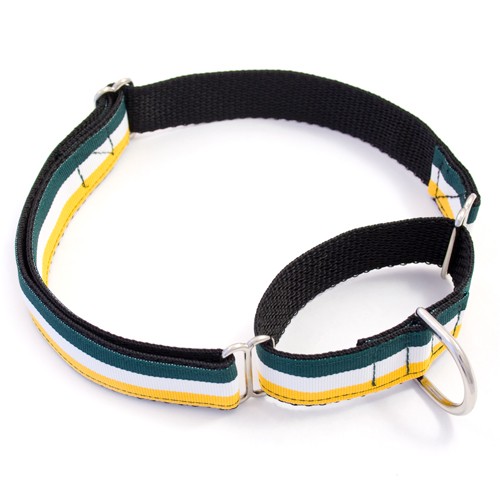What is one of the first things that puppy parents go out and buy their new puppy? A collar. And as simple as a collar may seem, the choices are actually endless. Collars with buckles, spikes, prongs, chains, bling, flashing lights, etc. Finding the right kind of collar that functions well seems to be an easy task but in fact, the safest collars are rarely the ones ever bought. Because let’s face it….collars are all about safety and are a necessary tool for dog training. Not only do they provide a ring to attach a tag with contact information on it, but it’s also the safety net when attached to a leash. I cannot tell you how many times I’ve seen dogs slip their regular, buckle style collars. OR how many times I’ve seen plastic buckles on collars break.
So….what collar style do I use and recommend? A martingale style collar, because there are no buckles that could break and the design (if properly fitted) prevents a dog from slipping the collar. The function is similar to a choke chain but without the harsh cinching that could cause airway distress, because if your dog pulls hard on it the pressure is more evenly dispersed along the wide, flat portions of the collar. This style collar is made of flat nylon material with metal D rings and slides, nothing that could easily break. That said, not all martingale style collars are quality, sometimes the metal rings and slides are of poor quality and can bend or snap. We’ve come to use and recommend custom made martingale collars from 2HoundsDesign for the last 6 years. They take a few weeks to be custom made, but they are of the finest quality and last for years.
How it works: there are two loops of fabric, one large and one small. The large loop goes around the dog’s neck and the small loop (called the control loop) has the D ring for the dog tag and leash to attach to. The large loop should be able to easily slip over the dog’s head and ears so it can rest comfortably around the neck. To ensure that the fit is just right, pull up on the collar so it rests right behind the ears which is the point at which the collar would slip off. Pull up on the control loop with the D ring, and if you cannot get the collar to slip past the dog’s ears then it is fitted properly. It should then fall to rest comfortably around the dog’s neck just above the shoulder.



















Leave A Comment